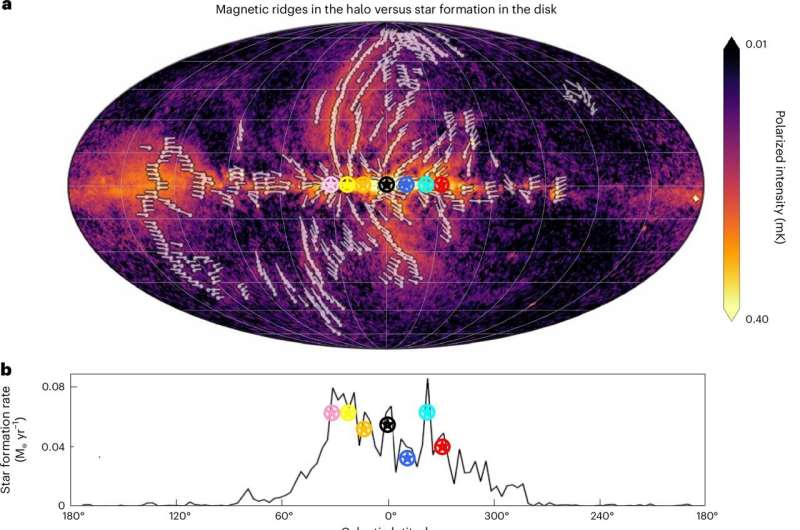
September 23, 2024 by Radboud University
Collected at: https://phys.org/news/2024-09-magnetic-halo-milky-discoveries-galactic.html
A new study led by the National Institute for Astrophysics (INAF), and with contributions from Radboud University’s Marijke Haverkorn, has unveiled significant insights into the Milky Way: a magnetized galactic halo.
This discovery challenges previous models of our galaxy’s structure and evolution. Researchers have identified several magnetized structures extending far above and below the galactic plane (reaching heights of more than 16,000 light-years or 150 quadrillion kilometers), revealing one of the origins of the so-called eROSITA Bubbles, which are large-scale powered by intense outflows of gas and energy that are also being generated by the explosive death of stars in supernovae.
Remarkably, these bubbles—observed by the eROSITA satellite (an X-ray telescope on board the Russian-German space mission Spectr-Roentgen-Gamma SRG)—stretch across the sky from horizon to horizon, providing the first detailed measurements of the Milky Way’s magnetic halo. These results were published today (Sept. 23) in Nature Astronomy.
The study discloses that the magnetic fields within these bubbles are highly organized, forming thin filamentary structures. These filaments stretch up to around 150 times the full moon’s diameter, showing their immense scale. The filaments are related to the hot winds with a temperature of 3.5 million Kelvin, ejected from the galactic Disk and powered by star-forming regions.
He-Shou Zhang, the first author of the article and a researcher at INAF, highlights that “our results find that intense star formation at the end of the galactic bar contributes significantly to these expansive, multiphase outflows.”
He adds, “This work provides the first detailed measurements of the magnetic fields in the Milky Way’s X-ray emitting halo and uncovers new connections between star-forming activities and galactic outflows. Our findings show that the magnetic ridges we observed are not just coincidental structures but are closely related to the star-forming regions in our galaxy.”
Galactic bar
The research team used a comprehensive multi-wavelength survey, covering frequencies from radio to gamma-rays, to analyze these structures. This detailed approach allowed them to confirm the extended nature of these magnetic features and their association with galactic feedback processes. Notably, the study represents the first observational evidence linking the Milky Way’s star-forming ring at the end of the galactic bar with the formation of large-scale galactic outflows.
“This study marks a significant step forward in our understanding of the Milky Way,” Gabriele Ponti from INAF says. “It is well established that a small fraction of ‘active’ galaxies can launch outflows, powered by accretion onto supermassive black holes or starbursts events, which profoundly impact their host galaxy.
“It is believed that such outflows are fundamental ingredients to regulate the growth of galaxies and the black holes at their centers. What is fascinating to me here is that we see that the Milky Way, a quiescent galaxy like many others, can also eject powerful outflows and, in particular, that the star-forming ring at the end of the galactic bar contributes significantly to the galactic outflow.
“Maybe the Milky Way reveals a phenomenon common in Milky Way-like galaxies, therefore helping us shed light on these objects’ growth.
This work was possible using more than 10 different all-sky surveys, covering frequencies from radio waves to gamma rays. He-Shou Zhang concludes, “Our work is a timely result. It is the first comprehensive multi-wavelength study for the eROSITA Bubbles since their discovery in 2020.
“The study opens up new frontiers in our understanding of the galactic halo and will help our knowledge of the Milky Way’s complex and impetuous star-forming ecosystem.”
More information: He-Shou Zhang et al, A magnetized Galactic halo from inner Galaxy outflows, Nature Astronomy (2024). DOI: 10.1038/s41550-024-02362-0
Journal information: Nature Astronomy

Leave a Reply